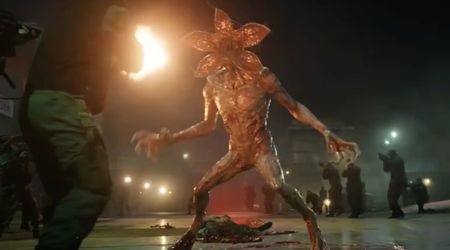'Vikings: Valhalla' Season 3: 5 facts Netflix show gets wrong about King Edmund

Contains spoiler for 'Vikings: Valhalla'
LOS ANGELES, CALIFORNIA: In 'Vikings: Valhalla' historical accuracy often takes a backseat to creative storytelling, especially evident in its portrayal of figures like King Edmund II (Louis Davison), known as Edmund Ironside.
While the series captures the essence of Edmund's brief reign following his father's death in 1016 and his subsequent demise after seven months, it deviates significantly from historical records.
Here are five notable inaccuracies the series presents about King Edmund, shedding light on how 'Vikings: Valhalla' blends history with fiction to engage its audience.
King Edmund in 'Vikings: Valhalla': fact vs fiction

In 'Vikings: Valhalla', the portrayal of King Edmund II as a young and inexperienced ruler contrasts with historical evidence. While the series depicts him as a "boy king," historical records suggest otherwise. Edmund was likely born around the same time as King Canute the Great, making them contemporaries rather than Canute being significantly younger.
This challenges the narrative convenience used in the show to depict Edmund as youthful and inexperienced. By the end of 1015, Edmund had already married Ealdgyth and fathered Edward the Exile and Edmund Ætheling.
Despite his youth, Edmund was thrust into leadership and faced significant challenges, including Viking invasions led by Canute. His short reign ended tragically in 1016, leading to Canute's ascension to the English throne and subsequent actions against Edmund's family.
The true story of Edmund II in 'Vikings: Valhalla'

In 'Vikings: Valhalla', the portrayal of King Edmund II diverges significantly from historical records, reflecting the series' approach to blending fact with fiction. While the show accurately depicts Edmund ascending to the English throne in 1016 after his father Æthelred II's death, it takes artistic liberties with his character and interactions.
The series portrays Edmund's relationship with his father as tender and supportive, contrasting with historical accounts of strained relations. Scenes showing Edmund praying at Æthelred's bedside and assuming a position of mourning are crafted for emotional impact but lack historical basis.
In reality, Edmund's defiance of his father's orders and his marriage to Ealdgyth, a politically charged move, suggest a more complex and contentious dynamic between father and son.
Historical inaccuracies in 'Vikings: Valhalla' in the case of King Edmund

In 'Vikings: Valhalla', historical events surrounding King Edmund II's reign are significantly condensed and altered for dramatic effect. While the series portrays Canute's invasion of England as a direct response to Æthelred's involvement in the Saint Brice's Day Massacre in 1002, historical timelines diverge.
The massacre occurred in 1002, but Canute's conquest of England and Edmund's demise in 1016 were separated by 14 years, depicting a compressed and simplified narrative for storytelling purposes.
Another notable deviation is the portrayal of Sweyn Forkbeard in Season 1, Episode 7 ("Choices"), where he interacts with characters despite historically dying in February 1014, almost three years before Edmund's death in November 1016.
Deconstructing Edmund's portrayal in 'Vikings: Valhalla'

In 'Vikings: Valhalla', King Edmund II is portrayed with a different characterization than historical records suggest. The series depicts him as overconfident and inexperienced, showcasing his struggles in combat and diplomacy, particularly in Season 1, Episode 3 and Episode 4.
These portrayals highlight his flaws and mistakes, leading to setbacks such as at the Battle of Assandun. Contrary to this portrayal, historical accounts praise Edmund for his bravery and military prowess, earning him the epithet "Ironside."
Known for his leadership in battles against Viking invaders, Edmund led his forces in several engagements, including those against Canute the Great's father, Sweyn Forkbeard. Despite his defeat at Assandun in 1016, Edmund's courage and determination in defending England against Viking encroachments remain his enduring legacy in history.
The fictionalized death of King Edmund II

In 'Vikings: Valhalla,' the depiction of King Edmund II's death diverges significantly from historical accounts, opting for a more dramatic narrative. The series portrays Edmund's demise as a covert assassination by Earl Godwin, a scenario not supported by historical evidence.
In reality, the exact circumstances of Edmund's death in November 1016, at the age of around 25 or 26, remain unclear and obscured by time. Historical speculation suggests Edmund may have succumbed to wounds sustained in battle shortly after the Battle of Assandun, a plausible scenario given the timing.
However, more colorful legends propose alternative theories, including an assailant attacking Edmund while he was on a toilet, akin to Tywin Lannister's fate in 'Game of Thrones'. These legends, though intriguing, lack reliable corroboration and are considered more fantastical than factual in historical discourse.
'Vikings: Valhalla' utilizes such legends and creative liberties to craft a compelling narrative around Edmund's death, balancing historical inspiration with dramatic storytelling for modern audiences.
'Vikings: Valhalla' Trailer
'Vikings: Valhalla' Season 1 and 2 are available for streaming on Netflix










